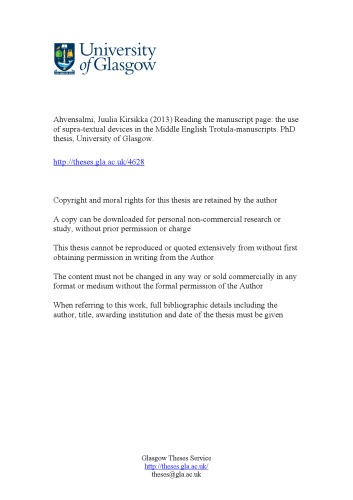Product desciption
Reading The Manuscript Page The Use Of Supratextual Devices In The Middle English Trotulamanuscripts Juulia Kirsikka Ahvensalmi by Juulia Kirsikka Ahvensalmi instant download after payment.
This thesis examines the use of supra-textual devices in the Trotula, a set of Middle English gynecological and obstetrical medical treatises. Through close examination of the thirteen manuscript versions dating between the early or mid-fifteenth century and the late sixteenth century, this thesis studies the way in which punctuation, layout, colour, marginalia and other visual devices are used to structure and present the texts. Combining quantitative and qualitative methods, this thesis examines the ways in which supra-textual devices are used to organise the texts into units of various type and length (major and minor sections, paragraphs, recipes, sense-units, sentences, clauses, phrases), and how the presentation of these units contributes to the reading of the text, showing that, despite the lack of standardised punctuation practices, each manuscript text uses a consistent system of supra-textual devices. Their use is not haphazard, as has previously been asserted; supra-textual devices are used purposefully to structure the texts and to communicate with the reader. The definitions of ‘sentence’ and ‘sense-unit’ in the Middle English context are also discussed, as well as the terminology used to describe medieval punctuation practices. In particular, the often-made binary division between ‘grammatical’ and ‘rhetorical’ punctuation is examined, showing that this division is neither very informative nor useful in practice for describing the systems of supra-textual devices present in medieval English writing. While the majority of the units can be described in terms of ‘sense-units’, the development towards the modern ‘sentence’ can be evinced in the data. This thesis also examines the role that scribes played in adapting and modifying the textual presentation in their exemplars, arguing that scribes played a key role in modifying the appearance of the manuscript texts to suit the needs of their audiences. Emphasising the importance of contextualisation, the final chapter focuses on the pragmatics of supra-textual devices, and how they can contribute to our understanding of the ways in which these texts were read and used by private individuals, professional medical practitioners or textual communities. This thesis argues that the Trotula had a number of different audiences, with varied literacy skills, and the supra-textual devices in the manuscripts suggest a range of reading practices, from private to communal, silent to oral, intensive to extensive. This thesis demonstrates that a close examination of supra-textual devices can bring new insights into Middle English grammar as well as scribal and reading practices.


